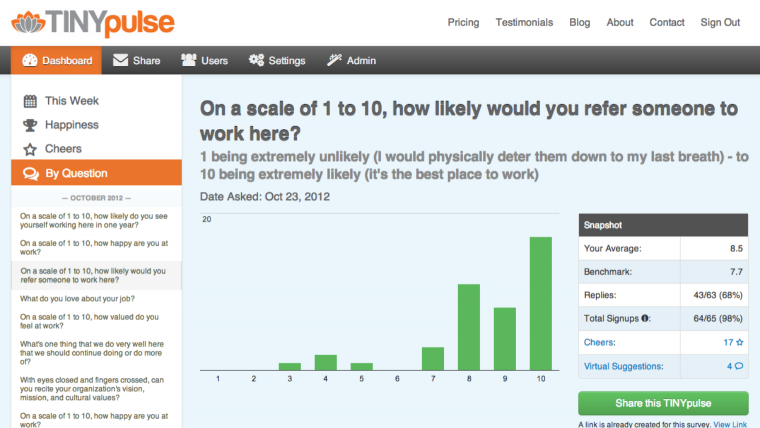Are your employees happy? Most firms would respond with a shrug. Unless there is a blazing row in the company kitchen ending with Marie from accounts pinning Keith from sales in a headlock, it won’t be clear there is a problem.
You can find out. There is a growing list of wonderful applications which can measure employee satisfaction and engagement. Even better, technology can take the lead in improving staff morale and performance.
Auto Trader is one of the pioneers. With 600 staff in Manchester and 130 in London, it relies on technology to monitor staff. Russell Warman, Auto Trader’s head of infrastructure, offers a back-stage view on how it works.
“We measure employee satisfaction using a third party tool from Tiny Pulse. They send an e-mail every fortnight to our product and technology, and customer operations teams. They ask specific questions. These can be tailored for particular issues or you can use the generic ones to benchmark against other corporations,” he says.
Mr Warman explains that a question, such as “How do you rate your work environment from one to ten”, provides a snapshot of morale. “Staff can add comments. Our operational leadership take these very seriously. They reply to each and every one,” he says, stressing that respondents are anonymised, though the senior staff who reply are not.

A number of organisations use Tiny Pulse to measure employee satisfaction
The firm has worked hard to improve productivity through technology. Badly timed internal phone calls are minimised by Microsoft Lync. “We use Lync for instant messaging, for audio conversations and for group conversations,” says Mr Warman. “It shows if people are free. You can say ‘Do not disturb’, so others know you are not available.”
Meeting rooms are booked using Condeco software. An Outlook plug-in lets staff book rooms, manage attendance, see whether rooms have the right video-conferencing kit, and even order food and drink from the caterer with a click. “It cuts costs and time,” says Mr Warman. With so many staff booking rooms an improvised method would break down.
There are quite a few creativity packages for firms to experiment with. Huddle is used by more than 100,000 companies, including Kia Motors and the National Grid. Files can be worked on by teams or individuals in multiple locations.
Last year, Anglian Water launched a social media service to generate ideas from its 4,000 employees. Called Think Space, based on Wazoku’s Idea Spotlight cloud platform, it can be used to solicit contributions on challenges. For example, staff were asked to come up with policies for Anglian Water’s Zero Waste goal. Steve Kaye, head of innovation, says: “We believe our staff to be a great, untapped source of innovation.
“Think Space provides a platform to post challenges and ideas, post feedback and create communities across the company. It will help make Anglian Water not only a workplace where people are engaged and want to stay, but also one that will attract the best talent from across the globe.”
Some of the employee engagement technologies on the market are simple to implement and use
The United Nations High Commissioner for Refugees (UNHCR) is also using software to harness the talents of all its staff. In 2014, it used the online platform Mindjet SpigitEngage to ask staff: “How can better opportunities be provided for refugees to learn and use a new language, both in school and their daily lives?”
The challenge lasted seven weeks and involved more than 850 UNHCR staff and partner organisations. SpigitEngage allows contributors to share ideas, comment on submissions and to vote for proposals. A question on refugees in urban areas generated 114 ideas, 430 votes and 1,200 comments in a six-week period. The winning idea saw the creation of an online database of information for urban refugees.
Some of the employee engagement technologies on the market are simple to implement and use. Media agency Carat uses a “thumbometer”, in which staff say at the end of the week if they have a good (thumbs up) or bad (thumbs down) week. The average score is 74 per cent thumbs up, with a peak of 88 per cent.
Managing maternity and paternity leave can be made easier by services such as My Family Care. Architects Rogers Stirk Harbour + Partners offer access to the service for its 200 staff, which offers a database of childcare providers, a zone for helping dads in the workplace, and webinars on balancing work and family care.
Efficiency improvement can come from something as basic as roster management. Heating firm Vaillant Group uses Kronos’ Workforce Attendance software to manage staff time. It records and manages shifts, productivity and training, and handles messages to staff when changes are made. It can provide analytics for the impact of events, such as absentee spikes during a World Cup. Across 13,000 workers, the Vaillant Group reports absence levels down 4.1 per cent to 2.8 per cent.
Technology can improve engagement on every level. Relying on informal processes or worse, nothing, seems positively perverse.


